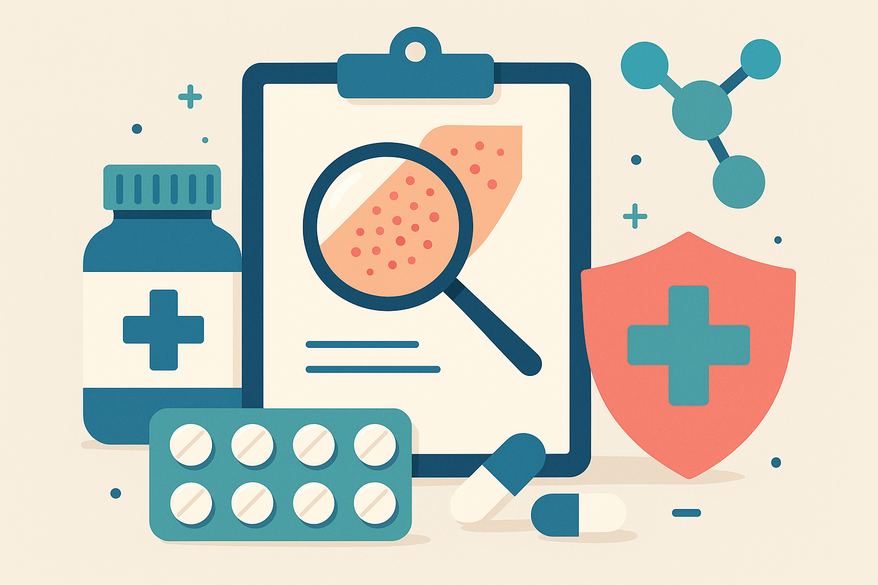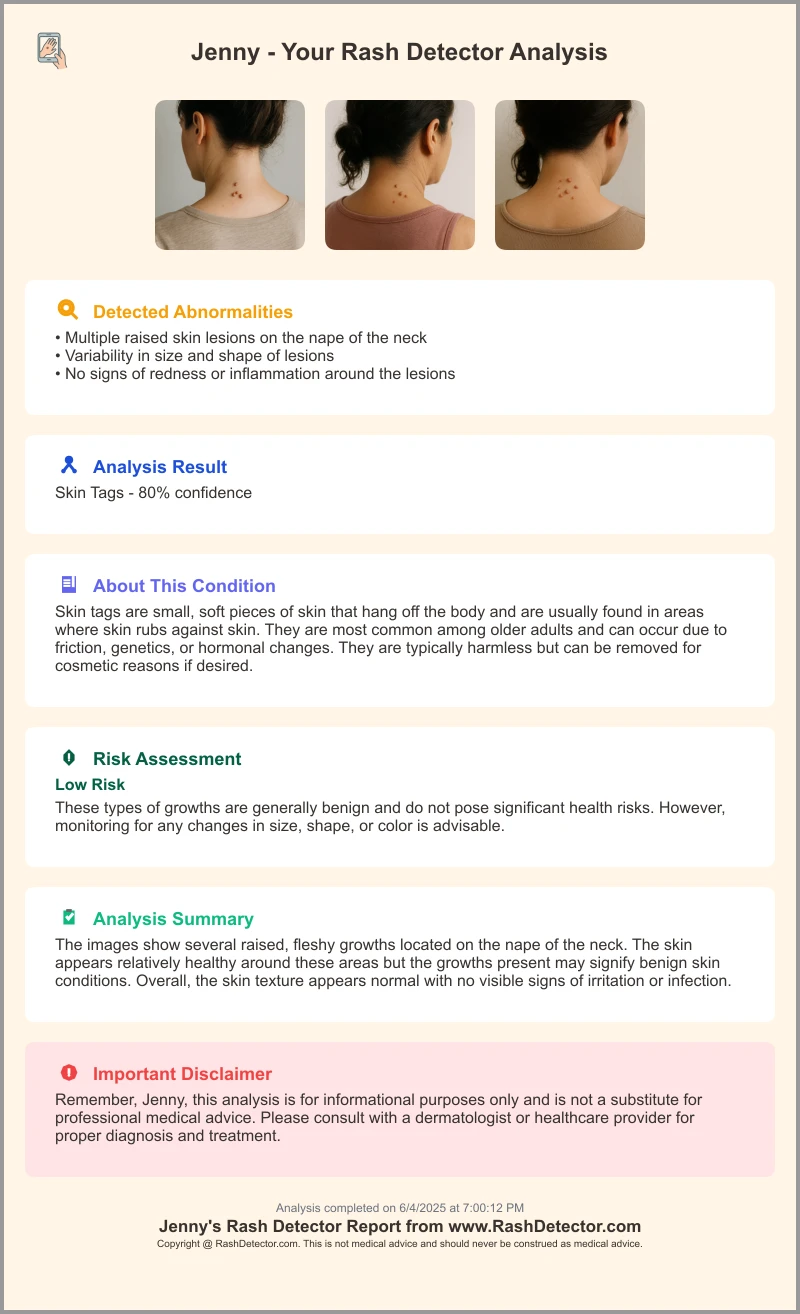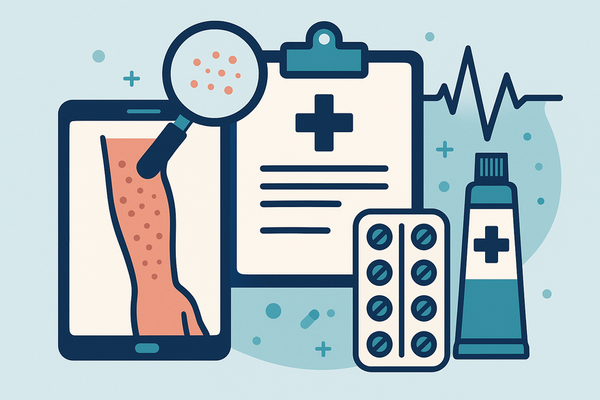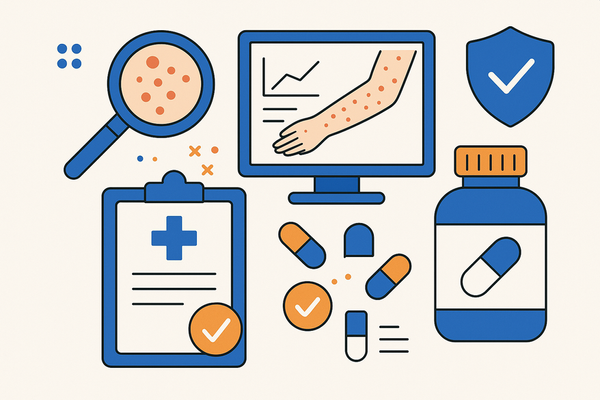The Ultimate Guide to Medication Rash Treatment: Identify, Manage, and Prevent
Discover how to identify, manage, and prevent medication-induced rashes effectively with our ultimate guide to medication rash treatment.

Estimated reading time: 10 minutes
Key Takeaways
- Recognize various drug-induced rash types—from mild morbilliform eruptions to severe Stevens-Johnson Syndrome (SJS) and TEN.
- Identify onset timing and symptoms to pinpoint the culprit medication promptly.
- Immediate steps: discontinue suspect drug, substitute alternatives, and apply supportive pharmacologic treatments (antihistamines, corticosteroids).
- Use home care—cool compresses, soothing baths, fragrance-free moisturizers—to ease discomfort.
- Know red-flag signs (blistering, mucosal involvement, systemic symptoms) that require urgent medical evaluation.
Table of Contents
- Understanding Medication-Induced Rashes
- Identifying the Rash
- Causes and Risk Factors
- Diagnosing Medication Rashes
- Medication Rash Treatment Options
- Home Care and Self-Management Strategies
- When to Seek Professional Help
- Conclusion and Recap
- FAQ
Introduction
Medication rash treatment is essential whenever a drug triggers an abnormal skin reaction. A medication-induced rash is any abnormal skin reaction that develops after taking a drug, ranging from mild, self-limiting eruptions to life-threatening conditions. Proper medication rash treatment matters because it brings symptom relief, prevents complications, and lets patients safely continue needed therapy. Recognizing and managing these rashes promptly can significantly improve outcomes and reduce long-term harm, says Harvard Health. Early attention keeps patients comfortable and lowers the risk of severe skin injury.
Understanding Medication-Induced Rashes
In this section on medication rashes, we explain what makes a skin reaction drug-related and not just a new spot or itch. Medication rash treatment begins with identifying an adverse drug eruption linked to a specific pharmacologic agent.
What are medication rashes?
- Adverse drug reactions that target the skin directly.
- Appear after a new medication or a dose change.
- Can mimic viral rashes or other skin conditions.
Key differences from other skin conditions:
- Timing: Link to the start or change of a drug.
- Mechanism: Involves immune or toxic response to medicine.
- Presentation: Specific rash types (see below).
Common types of drug-induced rashes:
- Morbilliform eruptions – Flat, red, itchy spots resembling measles.
- Urticaria (hives) – Raised, swollen, itchy welts that move around.
- Erythroderma – Widespread redness with peeling and scaling.
- Stevens-Johnson Syndrome (SJS) & Toxic Epidermal Necrolysis (TEN) – Severe blistering, skin detachment, mucosal damage.
- Drug Reaction with Eosinophilia and Systemic Symptoms (DRESS) – Fever, rash, organ involvement, high white blood counts.
Mechanisms:
- Immunologic (allergic) reactions
- Non-immunologic (toxic or idiosyncratic) drug effects
Identifying the Rash
Accurate medication rash treatment starts with spotting the signs and timing. Below are ways to recognize a drug-related skin reaction.
Signs and symptoms
- Redness, itching, or burning skin.
- Raised bumps, hives, or wheals.
- Blisters or peeling patches.
- Swelling in hands, feet, or face.
Timeline of onset
- Immediate reactions (urticaria/hives): within hours of taking a drug.
- Delayed reactions (morbilliform, DRESS): 4–14 days after starting a medication.
Steps to pinpoint the culprit
- Review recent drug starts or dose changes.
- Map symptom onset against medication timeline.
- Check for similar past reactions to the same drug or class.
- Note any new over-the-counter medicines or supplements.
For more on recognizing drug-related rash symptoms.
- Sources: Harvard Health Blog, American Family Physician
Causes and Risk Factors
Knowing what triggers a medication rash helps with prevention and treatment. Here we explore why some people react and who is most at risk.
Potential causes of drug rashes
- Allergic reactions: Immune system release of histamine and other chemicals (Managing Drug Allergy Rash).
- Side effects: Direct pharmacologic irritation of skin cells.
- Drug interactions: Two or more medicines amplify each other’s skin effects.
- Genetic predisposition: Specific HLA types increase hypersensitivity risk.
Who is at higher risk?
- Personal or family history of drug allergies.
- Previous rash from the same or similar medication.
- Certain genetic markers (e.g., HLA-B*15:02 with some anticonvulsants).
- Multiple medications taken together.
Mitigating risk
- Share allergy history with every provider.
- Use genetic testing if high-risk drugs are prescribed.
- Avoid unnecessary drug combinations.
Diagnosing Medication Rashes
Correct diagnosis guides effective medication rash treatment. Don’t guess—use these steps.
When to seek a professional diagnosis
- Rash is severe, widespread, or blistering.
- Rash appears with fever, swollen glands, or organ symptoms.
- You’re unsure which drug is responsible.
Diagnostic approaches
- Detailed medical history – List all prescription, OTC medicines, supplements; note timing of doses and rash onset.
- Allergy testing – Skin prick test for immediate reactions; patch tests for delayed hypersensitivity; blood tests for specific IgE antibodies.
- Skin biopsy – Small sample of skin to check for patterns of inflammation; used in severe or unclear cases.
For a quick initial assessment at home, the Skin Analysis App can analyze photos of your rash and generate instant insights with AI.

Pro tip: A clear diagnosis avoids mislabeling a safe drug and prevents risky substitutions.
- Sources: American Family Physician, NYU Langone
Medication Rash Treatment Options
This section covers immediate actions and medical therapies that form the core of medication rash treatment.
Immediate steps
- Discontinue the suspected drug under medical supervision.
- Substitute an alternative medication with a different chemical structure if available.
- Monitor for improvement or spread of the rash.
Pharmacologic treatments
- Antihistamines – OTC: cetirizine, loratadine, diphenhydramine; prescription H1 blockers for persistent hives; reduce itching, redness, swelling.
- Corticosteroids – Topical creams for mild to moderate rashes; systemic (oral prednisone or IV steroids) for severe or widespread reactions like SJS/TEN or DRESS.
- Supportive care – Emollients (fragrance-free creams), cool compresses, moisturizers to restore skin barrier.
Specialist and hospital management
- SJS/TEN: often requires burn-unit or ICU admission.
- DRESS: may need multi-organ monitoring in hospital.
- Consult a dermatologist or allergist for complex cases.
- Sources: NYU Langone, Mayo Clinic, American Family Physician, DermNet NZ, Cleveland Clinic Journal of Medicine
Home Care and Self-Management Strategies
Alongside medical treatment, these self-care steps support skin healing and comfort.
Cooling and soothing
- Apply cool, damp cloths for 10–15 minutes.
- Take short, cool baths with colloidal oatmeal.
Skin protection
- Use fragrance-free, hypoallergenic moisturizers twice daily.
- Avoid hot water, harsh soaps, and scrubbing.
Clothing and environment
- Wear loose, cotton clothing to reduce friction.
- Keep room temperature moderate to prevent sweating.
Lifestyle tips
- Stay hydrated to help skin repair.
- Eat a balanced diet rich in vitamins A and E for skin health.
- Sources: DermNet NZ
When to Seek Professional Help
Knowing warning signs lets you act fast and save skin and life. Urgent care may be needed even if the rash started as mild.
Red flags for immediate medical attention
- Rapid spread or large areas of peeling and blistering.
- Mucosal involvement (mouth, eyes, genitals).
- High fever, body aches, or swollen lymph nodes.
- Difficulty breathing, facial or throat swelling, or anaphylaxis symptoms.
Longer-term concerns
- Rash lasting more than two weeks without improvement.
- Recurring eruptions each time you restart a drug.
- Signs of infection: increased pain, warmth, or pus.
Emergency actions
- For anaphylaxis, use epinephrine auto-injector if prescribed.
- Call emergency services or go to the nearest ER.
- Notify your healthcare provider about the drug reaction.
- Sources: Mayo Clinic, American Family Physician
Conclusion and Recap
Medication-induced rashes range from mild redness to life-threatening skin detachment. Early recognition, accurate diagnosis, and timely medication rash treatment—discontinuation of the culprit drug, targeted medicines, and supportive care—are vital. Home strategies ease discomfort, but professional evaluation ensures the right therapy and avoids missteps. Remember red-flag signs like blisters, mucosal lesions, or breathing trouble demand urgent care. Prompt attention to medication rash treatment leads to faster recovery, safer medication use, and fewer complications. Always consult your healthcare provider for any new or worsening rash after taking a medication. Good skin health starts with informed, proactive treatment.
FAQ
- What are common signs of a medication-induced rash?
Redness, itching, raised bumps or hives, blisters, peeling skin, and sometimes swelling of hands, feet, or face. - When should I stop taking a medication and seek medical help?
If you notice rapid rash spread, blistering, mucosal involvement (mouth, eyes), high fever, difficulty breathing, or any severe reaction. - Can I prevent a drug-induced rash?
Share your allergy history, avoid unnecessary drug combinations, use genetic testing when indicated, and monitor new medications closely. - Are antihistamines sufficient to treat all medication rashes?
Antihistamines help with mild hives and itching, but more severe reactions may require corticosteroids or hospital care for SJS/TEN or DRESS. - How does home care support recovery?
Cool compresses, soothing baths, fragrance-free moisturizers, loose clothing, and hydration all help soothe and protect irritated skin.





